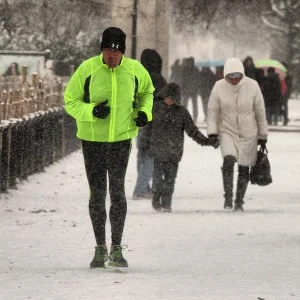

Well, it doesn’t really matter whether you’re one or the other because these tips we’ve put together will benefit you regardless.
Here’s how to make Winter Running in Calgary a little easier:
Know that winter running in Calgary is about maintenance – not speed. Don’t set unreasonable expectations. If you’re dealing with a really cold day, break your usual 6 mile run into two short 3 mile runs so you can avoid getting cold.
Really consider what’s on your feet. You want to really invest in a running shoe that has all-weather protection. We suggest a running shoe with a Gore-Tex membrane so that you can enjoy a waterproof yet breathable shoe that keeps your feet dry. You’ll also want something that has a rugged outsole that is equally efficient on the road and trail. Wear socks that wick away wetness but keep your feet warm. You may also want an over-the-ankle cut to bridge any gap between your pant leg and shoe.
Think about layers and vents when you’re getting dressed for a cold weather run. The rule of thumb for winter running in Calgary is to dress as if it is 15 degrees warmer. You want be warm, but you don’t want to sweat too much as that may lead to getting the chills. Think layers of technical fabrics to wick sweat – with zippers at the neck and underarm area so that you can vent air as you heat up. Always keep your core warm.
Don’t start cold. Give your body the chance to start warming up…Before heading outside, get your blood pumping inside.at. Run up and down your stairs, use a jump rope, or do a few yoga sun salutations. A speedy house-cleaning works, too! Just remember not to work up a sweat, as you want to avoid getting the chills.
Shorten your running stride and keep your feet lower to the ground. You will run more efficiently and reduce the risk of slipping, falling or straining muscles. Choose to run on fresh snow rather than ice or packed snow. You will get better traction on fresh snow and reduce the chance for slipping.
Remember that it gets dark out early, and snow drifts can make you invisible to traffic. Be sure to wear reflective, fluorescent gear. Having a headlamp or flashlight makes it easier to see where you’re going, and people will see you quickly.
Consider the elements: wind, rain, and more. Finishing your run with the wind at your back will stop the wind from blasting you after you’ve broken a sweat. You can also consider using something like BodyGlide or Vaseline to prevent wind burn and frostbite. If it’s raining, slip your feet into plasic baggies before getting your shoes on to help them stay dry. It doesn’t hurt to keep a change of clothes and a few towels in your car too. If you have to dry shoes overnight, crumple up newspaper and cram it tightly into your shoes, with the insoles removed. The newspaper soaks up the moisture.
Get out of wet/damp clothing as soon as your run is done. Don’t wait until the chills set in…your core body temperature will drop as soon as you stop running. Women need to get out of damp sports bras quickly. Put a dry hat on wet hair. Drinking something hot afterward helps a lot, too.
Happy running!

